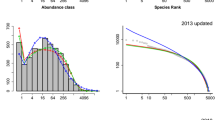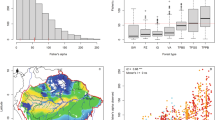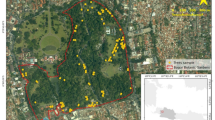Abstract
The analysis of remotely sensed images provides a powerful method for estimating tree abundance. However, a number of trees have sizes that are below the spatial resolution of remote sensing images, and as a result they cannot be observed and classified. We propose a method for estimating the number of such sub-resolution trees on forest stands. The method is based on a backwards extrapolation of the size-class distribution of trees as observed from the remotely sensed images. We apply our method to a tree database containing around 13,000 tree individuals to determine the number of sub-resolution trees. While the proposed method is formulated for estimating tree abundance from remotely sensed images, it is generally applicable to any database containing tree canopy surface area data with a minimum size cut-off.


Similar content being viewed by others
References
Clark DB, Castro CS, Alfaro Alvarado LD (2004) Quantifying mortality of tropical rain forest trees using high-spatial-resolution satellite data. Ecol Lett 7:52–59
Condit R, Sukumar R, Hubbell SP, Foster RB (1998) Predicting population trends from size distributions: a direct test in a tropical tree community. Am Nat 152:495–509
Condit R, Ashton PS, Baker P, Bunyavejchewin S, Gunatilleke S, Gunatilleke N, Hubbell SP, Foster RB, Itoh A, LaFrankie JV, Seng Lee HS, Manokaran N, Sukumar R, Yamakura T (2000) Spatial patterns in the distribution of tropical tree species. Science 288:1414–1418
Coomes DA, Duncan RP, Allen RB, Truscott J (2003) Disturbances prevent stem size–density distributions in natural forests from following scaling relationships. Ecol Lett 6:980–989
Earth Resource Mapper (1998) User Guide for Version 6.3, West Perth, San Diego, USA
El-Baz F (1984) The desert in the space age, In: El-Baz F (eds) Deserts and arid lands. Martinus Nijhoff, Boston, pp 1–29
Guenther M (2002) Die Verteilung der Baum- und Strauchvegetation im Kalahari Thornveld, Diploma thesis, University of Marburg, Marburg, Germany (in German)
Harcombe PA (1987) Tree life tables. Bioscience 37:557–568
Harper JL (1977) Population biology of plants. Academic, New York
He F, Gaston KJ (2000) Estimating species abundance from occurrence. Am Nat 156:553–559
Jensen JR (2000) Remote sensing of the environment. Prentice Hall, New York
Koukoulas S, Blackburn GA (2005) Spatial relationships between tree species and gap characteristics in broad-leaved deciduous woodland. J Veg Sci 16:587–596
Kunin WE (1998) Extrapolating species abundance across spatial scales. Science 281:1513–1515
Kunin WE, Hartley S, Lennon JJ (2000) Scaling down: on the challenge of estimating abundance from occurrence patterns. Am Nat 156:560–566
Levin SA (1992) The problem of pattern and scale in ecology. Ecology 73:1943–1967
Leckie DG, Gougeon FA, Walsworth N, Paradine D (2003) Stand delineation and composition estimation using semi-automated individual tree crown analysis. Remote Sens Environ 85:355–369
Lillesand TM, Kiefer RW (1994) Remote sensing and image interpretation. Wiley, New York
Loik ME, Breshears DD, Lauenroth WK, Belnap J (2004) A multi-scale perspective of water pulses in dryland ecosystems: climatology and ecohydrology of the western USA. Oecologia 141:269–281
Lorimer CG, Dahir SE, Nordheim EV (2001) Tree mortality rates and longevity in mature and old-growth hemlock-hardwood forests. J Ecol 89:960–971
Moustakas A, Guenther M, Wiegand K, Mueller K-H, Ward D, Meyer KM, Jeltsch F (2006) Long-term mortality patterns of the deep-rooted Acacia erioloba: the middle class shall die! J Veg Sci 17:473–480
MapInfo Professional (2000) User Guide for Version 6.0. Troy, New York, USA
Niklas KJ, Midgley JJ, Rand RH (2003) Tree size frequency distributions, plant density, age and community disturbance. Ecol Lett 6:405–411
Ogden J (1985) Past, present, and future: studies on the population dynamics of some long-lived trees. In: Harper JL (ed) Studies on plant demography: a festschrift for. Academic, London, pp 3–16
Richards JA, Xiuping J (1999) Remote sensing digital image analysis, Berlin
Rodriguez-Iturbe I, D’Odorico P, Porporato A, Ridolfi L (1999) On the spatial and temporal links between vegetation, climate, and soil moisture. Water Resour Res 35:3709–3722
Watson IW, Westoby M, Holm AM (1997) Demography of two shrub species from an arid grazed ecosystem in Western Australia 1983–93. J Ecol 85:815–832
Weiss H, Courty M-A, Wetterstrom W, Guichard F, Senior L, Meadow R, Curnow A (1993) The genesis and collapse of third millennium North Mesopotamian Civilization. Science 261:995–1004
Acknowledgments
We thank Arsenia Chorti for useful comments and help with the statistical analysis. The data used in the application were collected by Matthias Guenther and Dr. Karl-Heinz Mueller (University of Marburg, Germany) in the framework of the BIOTA-Africa project (http://www.biota-africa.org). Dr. Kerstin Wiegand (Friedrich-Schiller University, Jena, Germany) and Dr. David Ward (University of KwaZulu Natal, South Africa) had a contribution during field work verification. The comments of two anonymous reviewers considerably improved an earlier manuscript version.
Author information
Authors and Affiliations
Corresponding author
Rights and permissions
About this article
Cite this article
Moustakas, A., Hristopulos, D.T. Estimating tree abundance from remotely sensed imagery in semi-arid and arid environments: bringing small trees to the light. Stoch Environ Res Risk Assess 23, 111–118 (2009). https://doi.org/10.1007/s00477-007-0199-x
Published:
Issue Date:
DOI: https://doi.org/10.1007/s00477-007-0199-x




